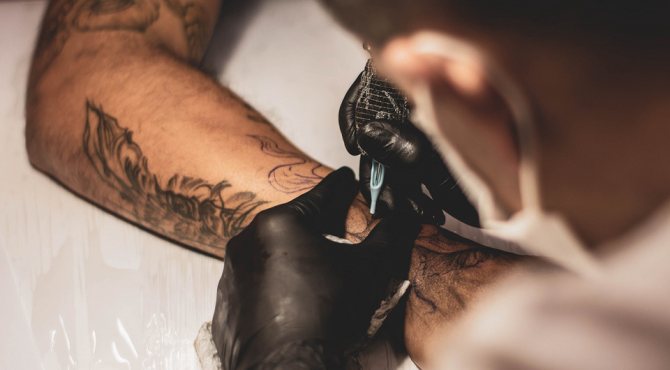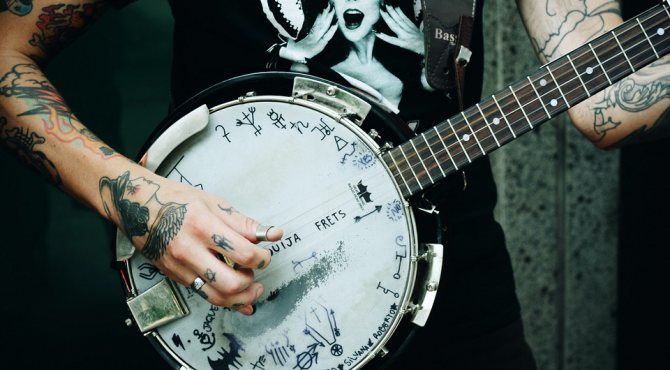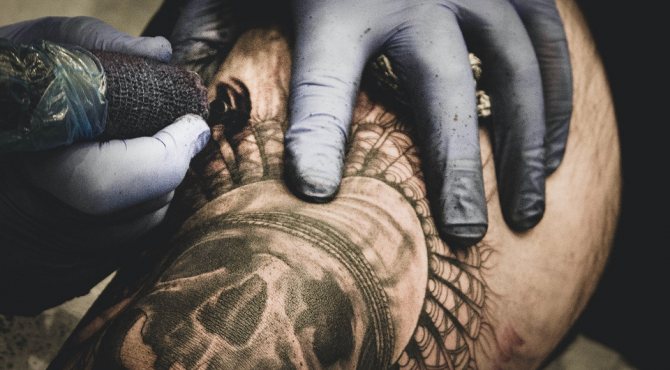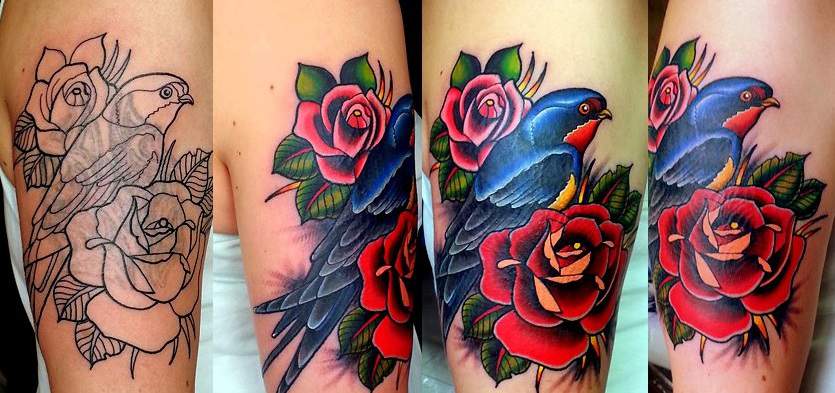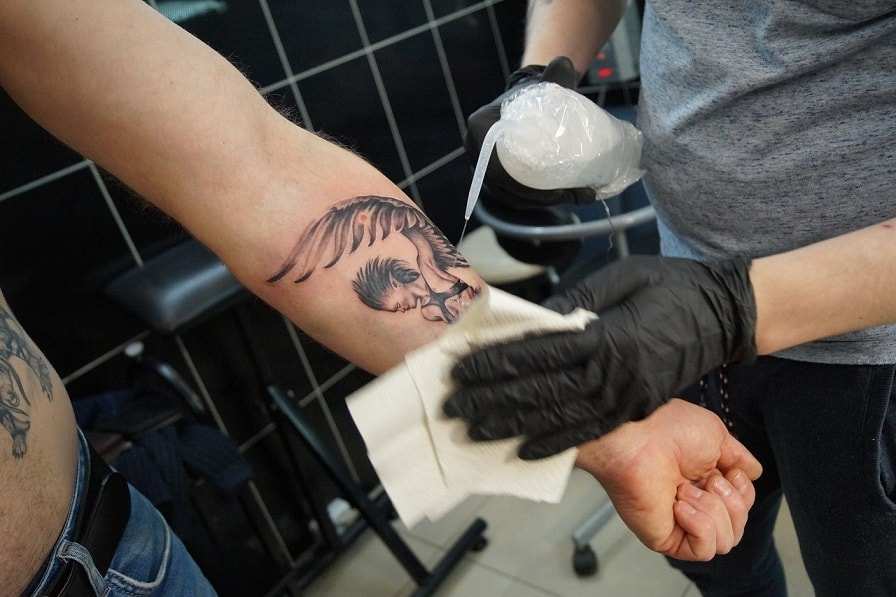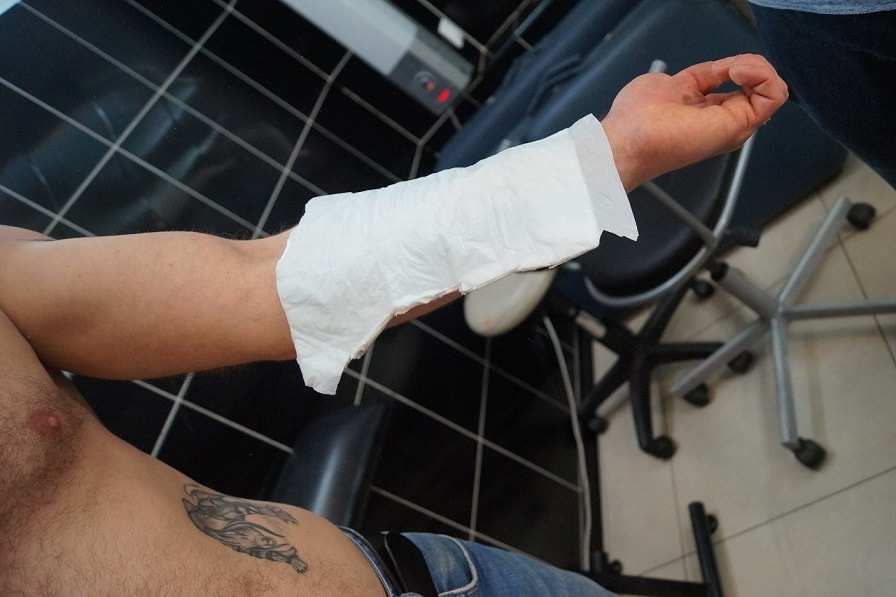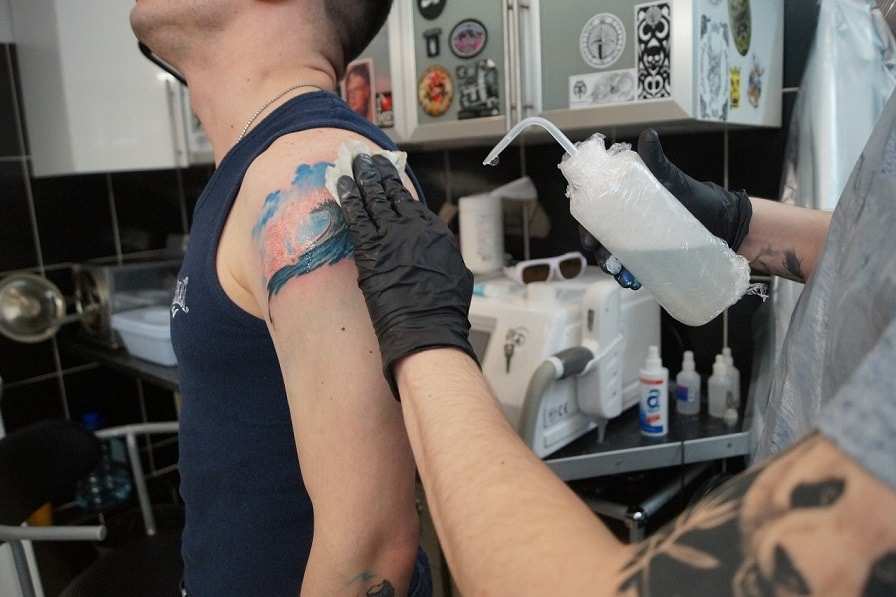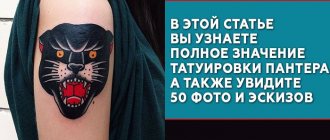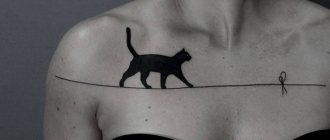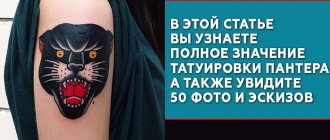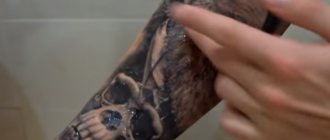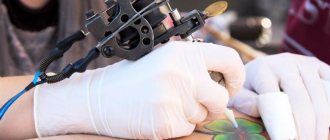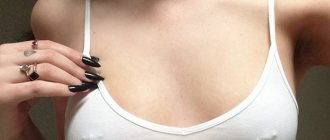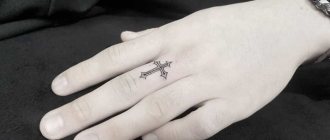Drawing on your skin is not only a work of art, but also a real stress to your skin, because it is inked with a needle.
- NewsTattoo artists told about the most annoying customer requests (poor masters)
And to avoid encountering infection and serious health problems, it's important to learn how to care for your tattoo.
The first step to success is to find a specialized studio and an experienced master who will do his job professionally, protecting you from the risk of infection during the process of drawing. Once he's done, the responsibility of caring for the fresh wound shifts to you.
So what is the care of a tattoo after tattooing? Let us now tell you.
What happens to the skin during tattooing and after
In modern salons, tattoos are applied with a special machine, the needle pierces the skin thousands of times. The resulting pain is due to damage to the nerve endings. The paint is distributed on the outer layer of the skin - the dermis. The procedure is painful and involves breaking the integrity of the skin, so the immune system activates its protective functions.
Blood cells - macrophages - are sent to the area of damage, which should absorb and remove foreign bodies. However, it is impossible to remove all the pigment, its particles are too large and cannot be broken down. Macrophages die, and the dye remains in the skin.
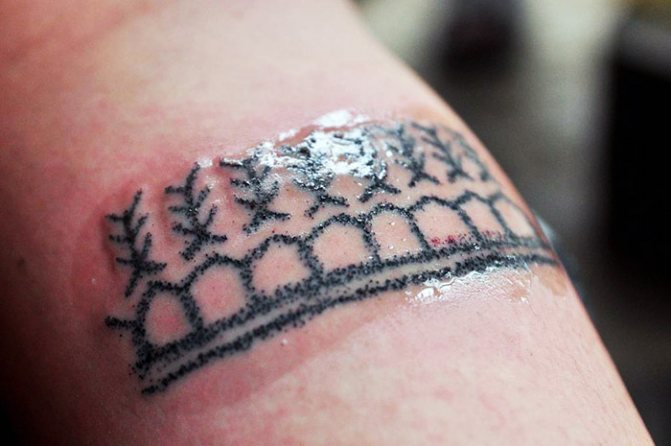
3-4 hours after tattooing, you can observe inflammation in the affected area. Leukocytes accumulate around it, aseptic inflammation develops in the tattoo area, it is accompanied by capillary dilation and overflow of blood. Excess pigment, leukocytes and erythrocytes penetrate the surrounding tissues and are excreted. The blood staining covers the area of the lesion and forms a crust on the skin.
Depending on the extent of the injury, the inflammation can last up to several days. Regeneration is not a quick process, at best the wound heals in 7 days, but more often it lasts longer.
Myth #1
A tattoo may not be cared for at all.


Thesis:
"Any tattoo is a shallow skin injury. It's no worse than a scratch and it's quite enough to just wash it off. After that, it will heal on its own without any intervention. What usually follows are examples of stories unsupported by any evidence. This is a characteristic of each of the fallacies.
In fact:
A tattoo is essentially the implantation of pigment particles under your skin. We use the word implantation because these particles are separated from the systemic blood flow in "lymph pockets" under the upper layer of the epidermis.
They are a foreign body, to which the body can give any reaction - from mild irritation to complications in the form of allergies or toxic reactions - if negative factors coincide.
For safe and complete healing, you will need to purchase an antiseptic and a specialized product to accompany hydration and healing.
You will need the antiseptic to treat the affected area during the initial healing stage (when there is discomfort and a secretion of sweat with paint residue) before applying the healing gel or cream. A fresh tattoo is a breeding ground for bacteria, which can enter it through the damage to the epidermis, so there is no way to neglect the use of a gentle antiseptic.
What not to do after the tattoo session
Crusts, if not properly cared for tattoo, may come off with some of the pigment, as a result, the design will be dull and uneven.
There are general recommendations on what to avoid after visiting a tattoo parlor:
- as well as before the procedure, during the healing period you should not drink alcohol, alcohol stimulates an increase in blood pressure, as a result of which the wound may bleed unnecessarily;
- To scratch the place of a tattoo, in the course of regeneration strong itching can arise, and if to influence on a site mechanically there is a probability of damage to a drawing;
- Exercise, it promotes profuse sweating, excessive moisture prevents rapid healing;
- too early removal of crusts from the tattoo site, this can lead to skin infection;
- Visiting water bodies, do not stay in the water for a long time, during the healing period, the pigment can be washed out, in addition, it is easy to get an infection on the unhealed area of the skin;
- In direct sunlight, it is possible to burn the paint.
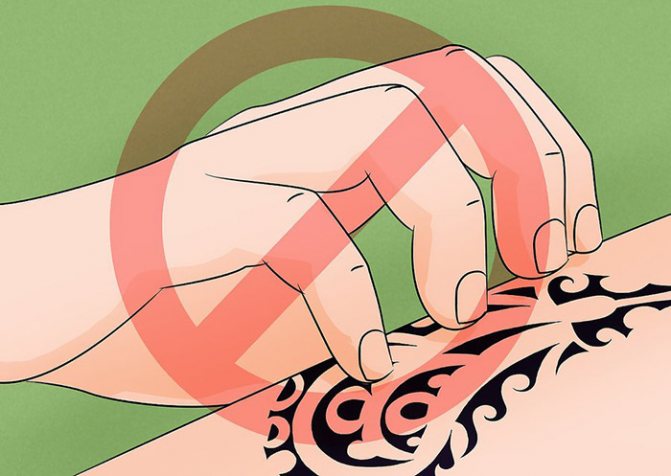

Do not scratch the tattoo during the healing process
It is strictly forbidden to isolate the tattoo with plasters, bandages, food film. This prevents the normal regeneration process.
The crust on the tattoo appears due to the natural drying of the protruding mucus. If there is no oxygen to the skin, it may fester.
Myth #2


Thesis:
Moisturizing alone is enough to care for a fresh tattoo and it doesn't matter at all what kind of product. You can use something as simple and cheap as petroleum jelly and baby cream.
In fact:
Vaseline
Vaseline is definitely not suitable for permanent care. It creates an impermeable greasy film that does not allow the epidermis to "breathe" and fully regenerate. More often the advice to care with petroleum jelly is accompanied by a warning - "Rinse more often and do not let the skin to wither.
In other words, you'll have to limit your physical activity much more than is prescribed in the standard healing memo.
You'll also need to avoid traffic, plan your day with care, and have everything you need on hand at all times to remove traces of your past application. As a bonus - greasy marks on your clothes will be your constant companions for the entire healing period.
baby cream
designed exclusively for children's skin. It also creates an impermeable film that will have a negative effect on healing. This function is necessary for children, but it is completely unsuitable for adult skin. Especially damaged and tattooed skin.
Any non-specialized creams can be used, as a last resort, when there is nothing at hand at all. It is better not to use them for complete healing.
Healing aids
During the first few days after the procedure, the crust on the tattoo needs special care. The master can recommend both drugstore remedies and professional cosmetics. Drugs prevent the growth of bacteria, as well as promote the healing of the wound.
Professional remedies relieve the symptoms of inflammation, they create a protective film, but at the same time moisturize the skin, which eliminates the feeling of tightness. All remedies used have a safe composition, the recommended preparations must necessarily have a license.
Ointments
The most commonly prescribed medications are Bepanten and Panthenol, but there are also analogues Traumel C, Solcoseryl. These anti-inflammatory agents are applied in a thin layer to the skin, promoting its regeneration. In order to prevent infection, there are ointments based on the antibiotic batriacin, but they are used only on the recommendation of a specialist. The pharmacy can offer Baneocin ointment, it also has Bacitracin in its composition.
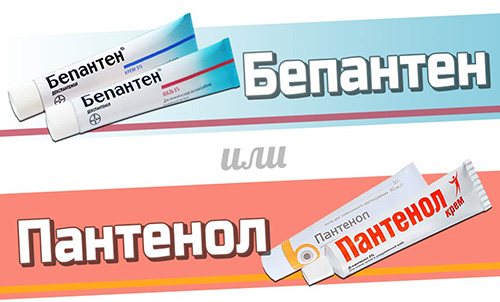

With the use of healing ointments, the bark on the tattoo will quickly go away
Professional ointments don't absorb as quickly, allowing for fewer applications.
The most popular products in the tattoo industry are:
- Dr. Pro;
- Tattoo Revive;
- Druid Tattoo healing balm;
- Tatoo Goo.
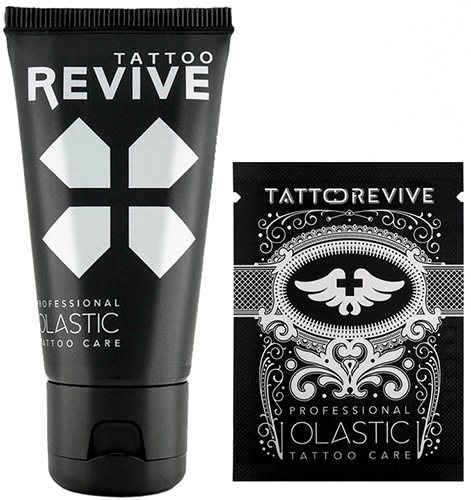

The basis of the composition of such products includes Chlorhexidine, Panthenol, vitamins, plant extracts and oils.
Healing film
Special films, due to their breathable structure, eliminate the need to wrap the skin with compresses, treat the wound with ointments and sprays and change the dressings regularly. The film is removed after the crust on the tattoo begins to come off naturally. The tattoo film has a breathable structure, the film itself does not perform a healing effect, it protects the wound from external irritants, thereby triggering the process of natural skin regeneration.
The film is tightly fixed to the skin, it does not need to be changed within 5-6 days, and the transparent coating allows to monitor the healing process. After removal the skin should also be treated with anti-inflammatory agents for 3-4 days.
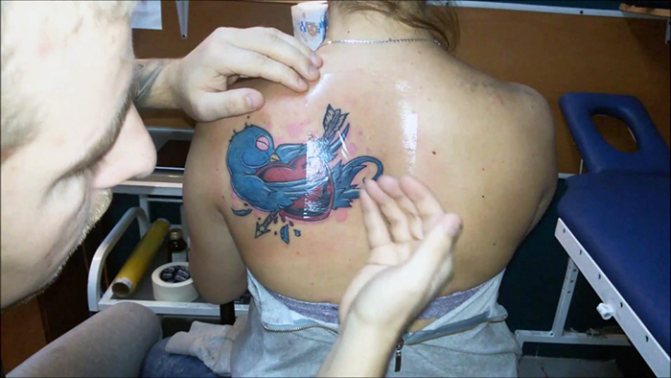

The crust on the tattoo using this method will be hidden under the adhesive sheet, which prevents moisture and tissue friction. The film is removed after the crust on the tattoo begins to come off naturally. However, sometimes the wound heals unevenly, some of the blood vessels may remain on the skin. The main task in this case is not to tear off this crust together with the film. More delicately and gently, it can be removed after preliminary steaming of the desired part of the body.
The main disadvantage of this method is the feeling of discomfort when removing, the protective film has an adhesive base. For insufficiently healed wounds, the process of peeling will be a little painful.
Popular types of films include:
- Suprasorb F;
- Tattoo Revive Protective Tattoo Film;
- EZ Derm Defender.


These products are sold both on a roll and as a cut. In a tattoo salon, a master will pick up the right amount of film. Application is not recommended for everyone, specialists often use this material for less voluminous and colored drawings. Due to the multicolor pigments, under the film, the mixing of colors is possible, which is not very aesthetically pleasing.
Special plasters
They are only used to attach medicated compresses during the healing period. As a separate method for healing crusts on tattoos, duct tape is not used, because due to the abundance of glue along with the plaster can tear off and the protective layer of crusts.
Why the skin peels off
The skin is a huge and very important organ that is constantly renewing itself. Every day we lose thousands of epidermal cells without noticing it. However, a fresh tattoo that begins to peel off allows us to see this process firsthand. To better understand how natural (and forced) skin renewal occurs, it is advisable to study its structure (see photo).
Even if the flakes of dead skin are not just white, but colored, this does not mean that the tattoo will fade, losing most of the ink used. The ink is too deep and will not be able to peel off with the epidermal cells. Peeling will in no way damage your image.
How a tattoo heals in days with proper care
The type of care depends on what kind of compress was imposed on the tattoo, if it is a healing film, then no manipulations within 5-6 days are required.
The main stages of healing:
| Stages | Duration | Features |
| Occurrence of crusts | Observed for 1-2 days after the procedure | It is a natural process; the liquid that appears may be transparent or contain a mixture of colored pigment. |
| The formation of a protective crust | Lasts up to 4 days | It is strictly forbidden to pluck or scratch this area. |
| Flaking | May last anywhere from 5 to 10 days | The crust on the tattoo begins to gradually peel off. Regeneration is accompanied by slight itching. |
Once the crusts are completely gone, the tattoo is considered completely healed. If there is residual inflammation, the area should continue to be treated with healing ointment or regularly moistened with Chlorhexidine.
Miramistin is often prescribed as an antibacterial agent.
Myth #6
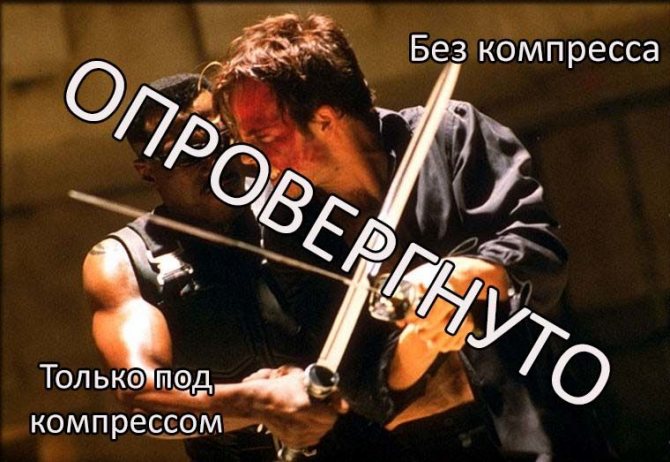

Thesis:
A tattoo should not be covered with anything/The tattoo can and should be kept exclusively under a bandage or compress.
In fact:
The absorbent compress and aerobic methods of healing are overwhelmingly combined because the daily activities of a person do not stop after the tattoo is applied.
While resting, it is common to let the epidermis "breathe" as much as possible by not using a compress and applying a thin layer of healing cream or gel to the tattoo. At times when the client is not at home - absorbent compresses are used.
Under the compress, however, you can not be under the compress for a long time, as on the skin may appear diaper rash. The combined method is ideal for the vast majority of cases.
How to take care of the skin so that no crusts appear after tattooing
Crusting on the tattoo is a natural process of wound healing for any person, so it is impossible to exclude the formation of crusts.
To alleviate the condition, you should follow these requirements:
- Protection. After the tattoo session, the master imposes a protective cream and seals this area with a special absorbent film. Within 2-6 hours, this compress should be removed.
- Proper healing. After removing the film, the tattoo can be washed with baby or antibacterial soap, rubbing is not allowed. Then, the area should be blotted with an absorbent cloth and apply a healing ointment. For 2-4 days, treat the tattoo regularly every 6-10 hours. To prevent the protruding mucus from sticking to the fabric of clothing, it is necessary to put a special or children's diaper over the wound, it can be fixed with a medical plaster or masking tape.
- Care during the regeneration stage. After the suction layer dries out completely there is no need to make compresses, within 3 days it is enough to treat the tattoo with healing ointment.
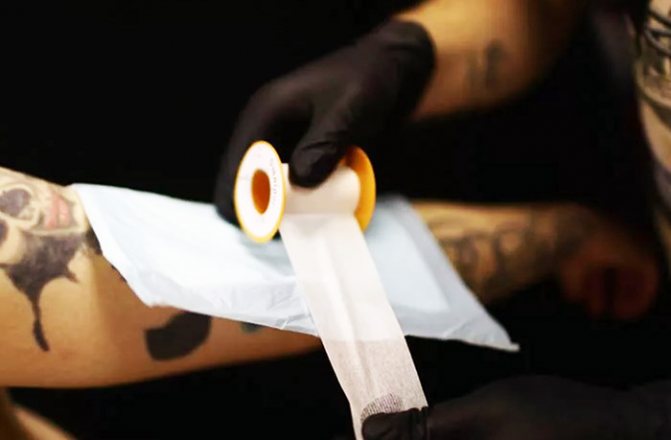

Compress for tattoo healing
During the recovery period, the skin flakes, you can not steam the wound at this time, it is necessary to wear loose clothing and avoid direct sunlight.
Laser correction. What are the advantages?
Sometimes, tattoo correction is needed in order to hide the defects of the image. For example, if some elements have ceased to please the owner or were made not very well. To completely remove a tattoo is quite a costly undertaking, as it requires the use of a laser. However, many masters offer to cover the old design by adding new colors or elements.
Laser tattoo correction involves not only the work of the machine, but also the labor of the master. Because first the places in the drawing that are most difficult to hide are removed. Sometimes only one session is made in which a laser is used. Then the drawing just gets lighter and easier to close.
After that, it's the tattoo artist's turn. He overlaps the old outline by adding new colors. It is a mistake to think that black tones will overlap everything else. On the contrary, colored elements can seem to "pop out" over the black color.
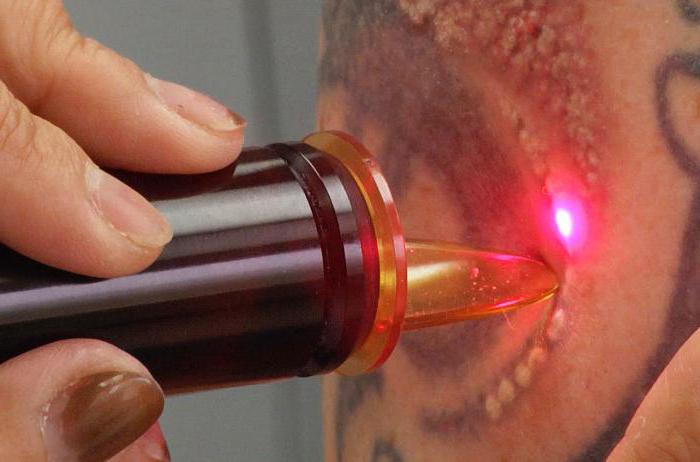

Time of healing, depending on the location of the tattoo, the volume, thickness and depth of the lines.
During 1-2 weeks heal areas with a small amount of subcutaneous fat, such as the back, ankle, neck and elbow joint. Large volume tattoos are usually applied in several stages, so the recovery period takes up to 1 month.
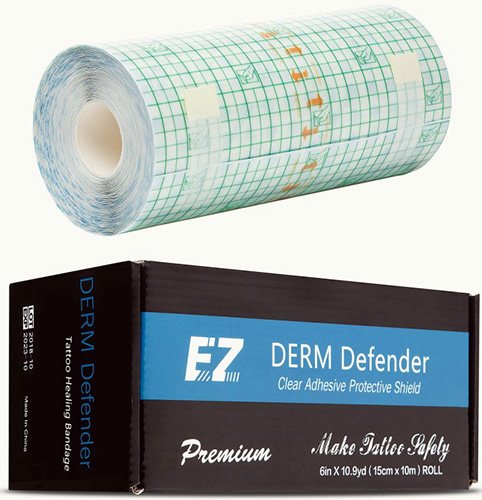

Tattoo Healing Film
Thin lines do not traumatize the dermis much, while deep, wide, thick drawings cause more discomfort when applied and take longer to heal. In areas of subcutaneous fat accumulation: on the buttocks, chest, abdomen, tattooing is perceived less painful, but it does not affect the regeneration period.
Allergic reaction
One of the reasons why there is an itchy rash on the places where the tattoo was made, becomes an allergy, which occurs more often on the dye pigments, less often on the processing materials. In this case, manifest such a negative reaction may not occur immediately, and after some time.
In addition to rashes, symptoms of allergies are flares of redness on the tattoo, unpleasant pain, and fever. Possible swelling of the throat, making it difficult to breathe.
What to do in this situation can only tell you a doctor, although at the first obvious signs of allergy immediately take antihistamines. Identified the exact cause after examination, and then prescribed a set of therapeutic measures. In complicated situations, it is sometimes necessary to remove the tattoo.
What to do if a tattoo heals too slowly
Each person, due to physiological characteristics, endures the process of tattoo healing differently. The inflamed wound will be painful within the established timeframe. The recovery time of the skin is relative - it can take from 2 to 6 weeks.
The client needs to analyze if there are reasons that prevent proper healing. Perhaps an excessive amount of ointment is applied, which prevents oxygen from getting in, or the person is constantly covering the tattoo with tight clothing. Even long showers cause the crust on the tattoo to swell, causing the inflammation phase to last a long time.
The problem may be that a person is taking medications or alcohol, and the body's defenses are compromised.
Myth #7


Thesis:
Getting a tattoo is best in the summer/fall/spring/winter because the rest of the time there will be problems with healing.
The truth is:
Healing at each time of year has its own nuances. In summer, you need to keep the tattoo open more, but avoid sunlight. In winter, under the layer of clothing that you are wearing most of the day, you need to change the absorbent compresses in time for the primary healing stage. In the fall and spring, the weather changes dynamically and you need to be careful whether you leave the tattoo open or put a thicker layer of healing agent on and spend some time under the compress.
Healing methods and remedies have evolved enough to adjust to your pace of life. Yes, a fresh tattoo still brings some limitations to life. However, they are much easier to bear than they were 5 or 10 years ago.
Signs of Complications and Treatment
There are cases when the healing of the tattoo provokes other diseases. An open wound is a gateway for germs, which is why it is so important to treat and disinfect the new tattoo.
It is worth worrying if the following symptoms are absent:
- Bleeding (meaning blood, not the secretion of suds);
- An increase in the volume of the area of inflammation;
- The occurrence of an allergic reaction;
- formation of festering.
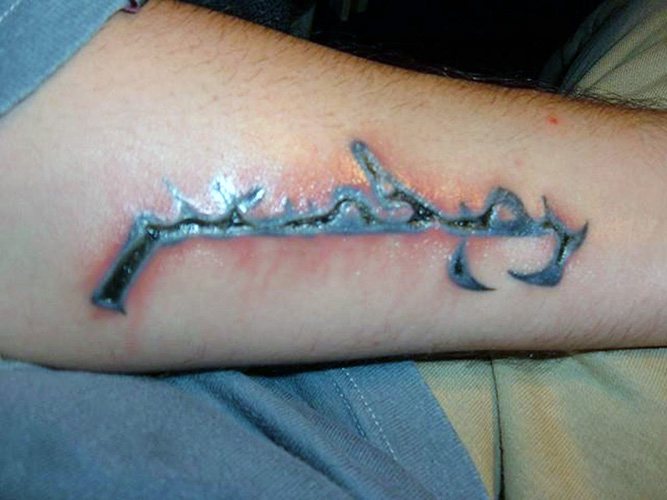

In all of the above cases, you should consult a dermatologist and be sure to inform the master in the tattoo salon.
The possibility of infection
If, while complying with all the prescribed care procedures, an already lingering fresh tattoo itches and peels, it becomes a reason to contact a dermatologist.
To understand independently that on a tattoo inflammatory process has begun, it is possible on tactile sensations of hot skin at touch to it the palm.
Gradually, the contours of the impaled design are surrounded by reddened areas, indicating additionally that the tattoo itches due to the development of infection. After the prescribed therapeutic measures, everything will gradually normalize.
What improper tattoo care leads to in the long run
Neglecting proper care results in the crust that forms on the tattoo taking much longer to wear off.
Other consequences include:
- The appearance of scars and scars;
- Rejection of the pigment in the form of an allergic reaction;
- distortion of the pattern, fade colors;
- the formation of chronic skin diseases.
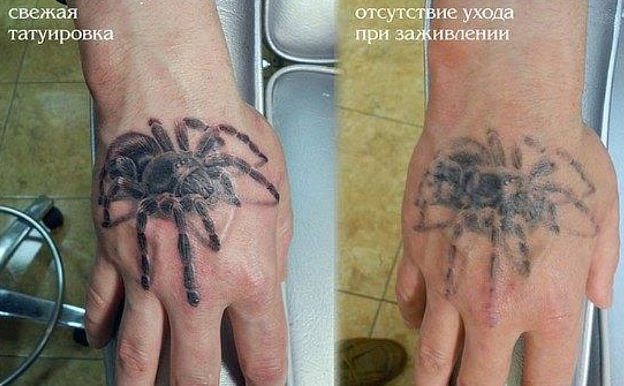

Complications can be caused both by the client's neglecting the rules, and by the master's negligence. Professionals should ensure sterility of tools and work only with quality materials. The crust formed on the tattoo does not appear immediately, but the possible consequences should be notified even during the procedure.
Myth #4


Thesis:
The more expensive the product, the better it is.
The truth is:
Absolutely all cosmetic products are created for specific purposes, and some, in addition, for specific skin types and even application sites, such as neck/lapels/marks/veins, etc.
Targeting a product affects its composition, the complexity of production and, as a result, the cost of the final product.
However, this does not make the cosmetic a universal product or one with "special" healing properties. And the active components used for highly specialized cosmetic creams, on damaged skin can lead to rashes, itching and serious consequences in the form of allergies.
On the final stage of healing, when the upper layer of skin has already regenerated sufficiently - tattoo becomes less demanding to the composition of creams, but in the case of highly specialized cosmetics, you can risk only in case of force majeure. Always try to use specialized care products.
Exposure to ultraviolet radiation
If a fairly old tattoo itches, about a year after it was done, the cause may be a reaction to ultraviolet radiation. This is due to the structural formula of the ink. If they contain cadmium, when exposed to natural sunlight or an artificial stream of rays in a tanning bed, the puncture sites begin to lift and the surface becomes convex.
Rejection is mainly on red and yellow colors that contain cadmium. Sometimes the triggering factor is green inks containing chromium oxide, or orange inks containing selenium cadmium sulfide.

